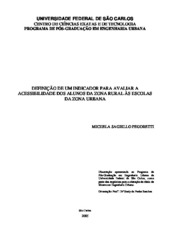Definição de um indicador para avaliar a acessibilidade dos alunos da zona rural às escolas da zona urbana.
Abstract
The main objective of this work was to establish an indicator to evaluate students accessibility from rural to urban areas. It involves the broad issue of rural versus urban dichotomy and the evolution of social and spatial segregation process in the cities, which reaches the rural area, isolsting it and restricting people s access to different activities. It also establishes the importance of cities accessibility improvement by rural
zones inhabitants, through means of transportation, as a way of mitigating opportunity difference that reach people who live in the field, specially those who are attending school. This paper analyses the situation of rural school transportation in Brazil, identifying the most relevant attributes that interfere in the accessibility: children walking distances, travel time and characteristics of the roads and safety/comfort in the
vehicles. The accessibility patterns were evaluated in regard to the trips from the residence to the bus stop (walk trip) and the trips from the bus stop to the schools (by motorized vehicles). The methodology for the research development consisted on the use of a multicriterial evaluation method, composed by four steps: attributes choice, determining attribute importance, normalization and combination. In one of these steps, a survey was made with 120 (one hundred twenty) professionals who act on education and transportation areas to evaluate the importance of the accessibility attributes and higher acceptable distance values travelled by foot and the travel time to school. The case study was developed in the city of São Carlos, where the defined indicator was applied to seven (07) transport lines in the afternoon period on the district of Água Vermelha. The final research result, generated on TransCAD, is shown by means of a map of multicriterial accessibility of the chosen region. The analyses realized about the results, prove that more distant boarding places from rural schools do not have, as a rule, lower levels of accessibility and that minimizing students walking distances from home to the boarding stops is a very important point to be considered on the planning of
rural school transportation.
